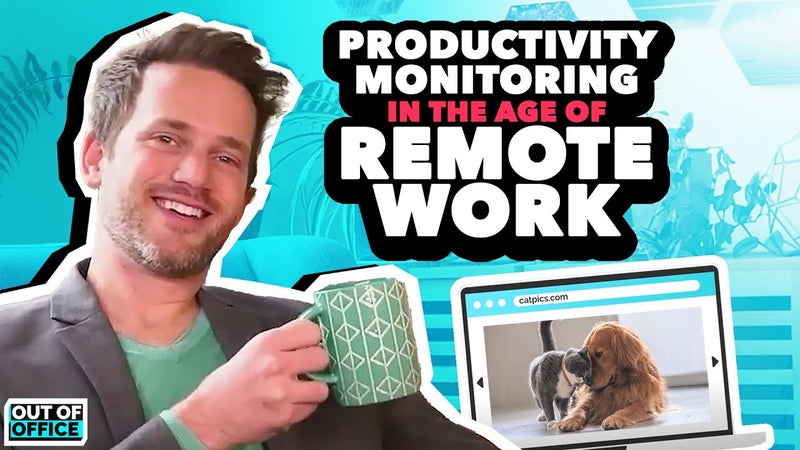Contents
- Hey! Welcome to Out of Office
- Dropbox and Spotify: Proving Remote Work Slaps
- The Facts
- Apple: Not Ready to Believe in Remote Collaboration
- The NYT: Productivity Monitoring Exposé
- Context is Key
- The Man With 11 Remote Jobs
- Encouraging the Conversation
- This Week’s Shareable
Two tech giants prove remote work is better, a NYT reveal-all on productivity monitoring, and a guy that has 11 full time WFH jobs – the first ever Out of Office!
📈 Dropbox and Spotify: Big wins with ‘virtual first’ policies
📉 Apple: Still hoping people will return to office
📰 The New York Times: A productivity monitoring deep dive
⚠️ NBC: A super shady trend called overemployment
Hey! Welcome to Out of Office
I’m so excited to have you here for the debut of Out of Office, Crossover’s new web show that’s been taking the world of remote work by storm.
Did you ever want to flee your office for the rest of your life because you had enough of endless commuting, pointless meetings, and hours behind the same desk every day?
I know the feeling.
I’m your host Andrew Allen, and every week I’ll be diving into the hottest topics making headlines, so that you can stay ahead of the latest trends in remote work - as I share insider tips on what life really looks like when you go remote.
So if you want to
- Stay informed on the business of remote work
- Help make working remotely an important part of workplace culture
- Hear about the latest full-time completely remote jobs
It’s great to have you with us!
Let’s get stuck in –
Dropbox and Spotify: Proving Remote Work Slaps
After the pandemic, people didn’t want to go back to the office.
You know who listened? Dropbox and Spotify.
These two tech giants made the excellent decision to shift their workforce from in-person to mostly remote, proving that large companies can in fact ‘read the room’ (even when there isn’t one).
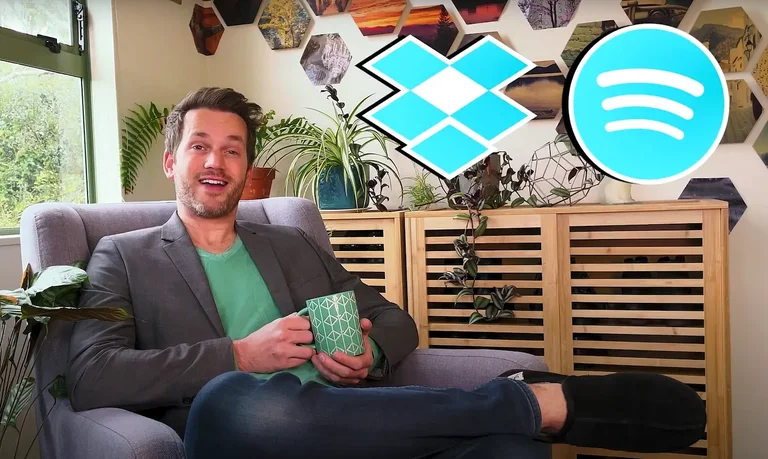
“Under a new program dubbed ‘Virtual First’ launched in April 2021, Dropbox employees are expected to work virtually at least 90% of the time.”
While @Amankidwai writes –
“Spotify announced its new work model called ‘Work from Anywhere.’ The policy lets employees determine how often they work from the office and where they work.”
Inspired!
And now both companies are reaping the statistically proven benefits of that transition.
The Facts
● Dropbox reports almost double the applicants per job post than before
● Job offer acceptance rates are up 126%
● Spotify reports 15% lower attrition in the second quarter of 2022 than in 2019
● Spotify’s Black & Hispanic employees increased from 12.7% to 18% in 2021
● Their global women in leadership increased from 25% to 42%
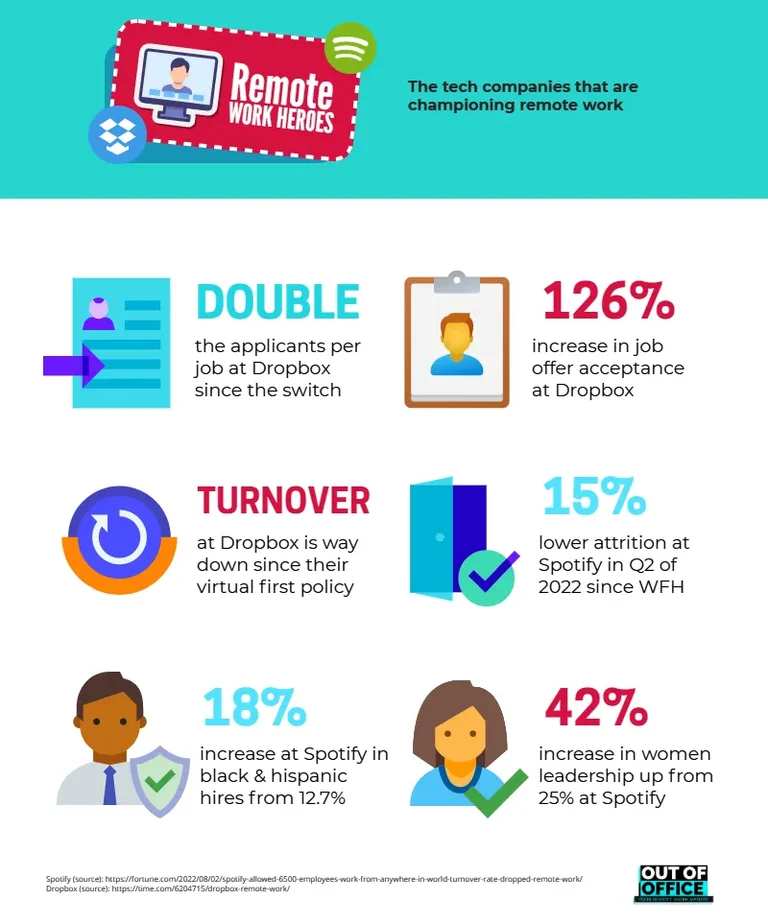
Share our mini infographic showcasing remote work heroes
Clearly the quality of the talent pool at these companies is on the rise thanks to remote work. They're going to clean up!
Apple: Not Ready to Believe in Remote Collaboration
In a move that has surprised absolutely no-one, for the third or fourth time Apple has renounced remote work, citing a culture of in-person collaboration as the culprit.
“Apple has told its employees they must return to the office in September for at least three days a week.”
It will be interesting to see if they stick to it this time. It’s been 16 months since they first announced a return-to-office plan without much success implementing it.
In the meantime, high value employees like Ian Goodfellow, a director of machine learning, have left the company because of its inflexibility with remote work.
It’s clear to us which companies are listening, and which are losing talent.
How do you like them, Apple?
The NYT: Productivity Monitoring Exposé
The New York Times did a deep dive into how companies are measuring employee productivity recently, when working from home.
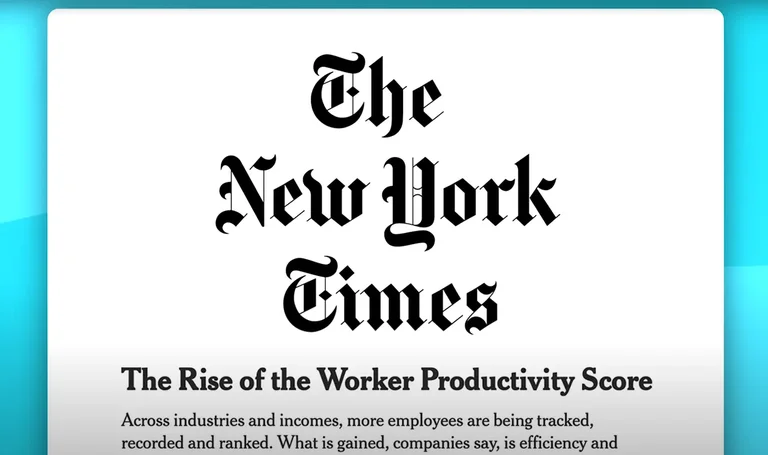
The story said that tracking software was not the way to go when managing a remote workforce. But we found it lacked a global perspective.
What happens when US companies want to hire great people across the world – but they need a way to manage fraud?
Without productivity monitoring, companies won’t hire the best of the best in places like India, the Philippines and Nigeria. And we don’t believe in excluding everyone because of a few bad eggs.
Get more insight into our thoughts on productivity here.
Context is Key
Let’s face it, no-one likes the idea of being watched.
Though for hundreds of years employees have always been monitored.
Back then it was the punch card system and roaming managers peeking over the shoulders of their workers.
Now we have technology.
People have been grappling with accurate productivity measurement and fraud prevention since the beginning of time.
So, when everyone was suddenly working remotely because of the coronavirus, companies had to quickly leap to remote monitoring.
These sudden shifts have been understandably rocky. No surprises there.
Like most new technology, a balance will eventually be struck that will suit everyone.
In the meantime, context is key!
The Man With 11 Remote Jobs
Interestingly, the NYT story broke just two days after an NBC film crew interviewed a bunch of people who confessed to working multiple full-time jobs - and their employers have no idea.
It’s called being overemployed, and it’s as shady as it sounds.
One guy interviewed by NBC said, “The more jobs I have, the closer I get to retirement, so I’ve added more and more jobs over time until I got to 11.”

Characteristics of being overemployed include
- Having more than 1 full time remote job
- Pretending to do a good job but doing the bare minimum
- Having a goal to make as much money as possible
- Keeping employers in the dark about each other
You can watch the original NBC News clip and hear Isa Gutiérrez report here.
Realistically, if we want the future of work to be remote then this kind of thing can’t happen. It devalues the fact that remote work is a credible alternative to working at the office.
The question of how to accurately measure someone’s input, to prevent this kind of fraud is going to be a huge conversation moving forward.
Before we dismiss productivity monitoring as a bad thing, let’s engage in the discourse.
Subscribe
Encouraging the Conversation
At my last job, I worked in an open plan office.
My boss and co-workers could see what I was doing all the time.
They could see if I was slacking off or pulling my weight. They knew if I was in meetings or playing Candy Crush all day. Monitoring just isn’t that weird.
It makes sense that companies want a certain level of accountability, like they always have.
If you’re a good person who isn’t trying to pull the wool over anyone’s eyes, and you’re just doing your job – is productivity tracking really that bad?
I’ve spent the last 18 months using productivity software every single day as an independent contractor for Crossover.
Full disclosure – we were mentioned in the NYT article.
And no, we don’t think tracking is such a big deal.
I would happily do this for the rest of my life instead of having to report back to the office to manage that level of monitoring.
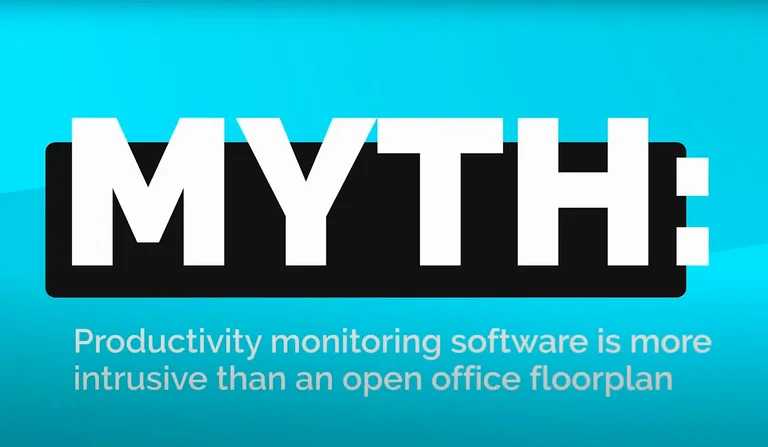
Ultimately, this kind of software feels intrusive for a while – then fades into your day. It’s far less unpleasant than an open plan office and gives me way more privacy than being in-person.
I predict that in a few years a degree of remote monitoring will be the norm everywhere. We will come to accept it, like a security guard who works at the bank accepts cameras.
So, if you’re browsing on your work laptop, you’ll know not to visit certain sites. And you won’t have anything to worry about – unless you’re the guy trying to hold down 11 full-time jobs.
Thanks for reading and remember – the future of work is out of office.
Andrew
This Week’s Shareable
- “Out-perform. Out-attract. Out-retain.” – Drew Houston, CEO of Dropbox believes companies that embrace #remotework will win big.


